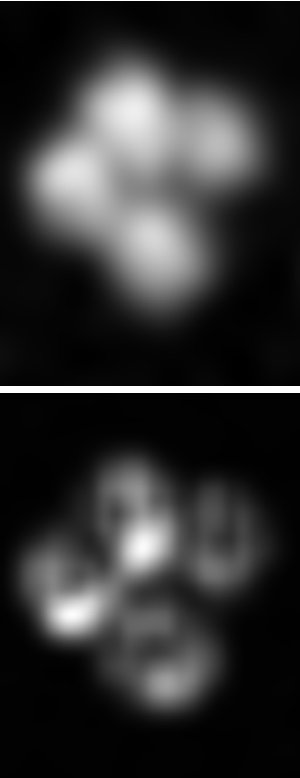Bleaching Cleans Up Cell Images
Photoacoustic imaging is like ultrasound imaging, but it uses light pulses to generate the sound waves inside the tissues to be imaged, such as blood vessels or tumors. A new photoacoustic technique described in Physical Review Letters improves the resolution beyond the usual diffraction limit, allowing researchers to distinguish individual cells and the structures inside cells. The method could allow subcellular imaging of biological tissues without the need to add fluorescent dyes or other contrast agents.
Photoacoustic microscopy, or PAM, is based on the photoacoustic effect. A short pulse of light hits a material, causing it to heat up and expand a bit, which produces sound waves that are detected by a transducer. The stronger the light absorption in a particular region, the louder the emitted sound. To build up an image of biological tissue, researchers sequentially focus the laser at many points inside the sample and record a single “pixel” of data from each one. Certain biomolecules, such as hemoglobin in blood or melanin in the skin, provide very strong photoacoustic signals, so when they are present, no artificial dye is required [1]. Other techniques such as fluorescence microscopy usually require dyes or other contrast agents. PAM can also image deeper into a living specimen than fluorescence microscopy because sound waves travel longer distances through tissue than does the glow of fluorescence. These properties allowed researchers to use PAM to map the blood vessels in a human hand, and they hope to use it on patients more generally [2].
The spatial resolution of PAM is determined by the width of the laser focus region, which can’t be squeezed any smaller than about 200 nanometers, the diffraction limit for the laser light. Fluorescence microscopy and other techniques have tricks for beating the diffraction limit, and now Junjie Yao and his colleagues at Washington University in St. Louis have developed the first such scheme for PAM. Like some high-resolution fluorescence techniques [3], the new PAM scheme takes advantage of photobleaching, an effect whereby some molecules lose their ability to absorb light of a particular wavelength after being hit with a pulse of that wavelength. In the case of PAM, the deposited heat of each light pulse causes a permanent change in the shape of some of the absorbing molecules. “Photobleaching is actually an unwanted byproduct in most optical bio-imaging, and it is really hard to avoid,” says Yao. “Our method changes this downside into a useful enhancement in spatial resolution.”
In their technique, the researchers use two consecutive pulses focused at the same point. The first pulse predominantly photobleaches those molecules in the center of the focal spot, where the intensity is highest, leaving most of the peripheral molecules unbleached. The second pulse, therefore, is only able to generate sound waves from a hollowed out shell around the central focal region. When the researchers subtract the second sound signal from the first, they essentially shave off the blurry edges and are left with a sharper pixel. The technique works because the amount of photobleaching depends very sensitively on the intensity.
The team found that the resolution improved by a factor of 1.7 for red blood cells full of hemoglobin and a factor of 2.0 for melanin-filled cells in a skin cancer tumor called a melanoma. They also imaged gold nanoparticles, which have no internal structure but are small enough ( 150 nanometers in diameter) to serve as a resolution test. The particles were resolved at 80 nanometers, a factor of 2.5 below the diffraction limit. The photobleaching technique may prove especially useful in studies of melanoma cells, where biologists are interested in sub-cellular features smaller than the diffraction limit.
Hao Zhang of Northwestern University says the work is “a significant step forward in photoacoustic microscopy.” He points out that similar diffraction-beating techniques have existed in fluorescence microscopy for 20 years [4], and they are often much faster than PAM. But they tend to rely on fluorescent markers and complicated laser systems. “The advantage of PAM is it can be cheaper because the requirement on the laser is lower,” Zhang says.
–Michael Schirber
Michael Schirber is a Corresponding Editor for Physics Magazine based in Lyon, France.
References
- L. Wang, J. Xia, J. Yao, K. I. Maslov, and L. V. Wang, “Ultrasonically Encoded Photoacoustic Flowgraphy in Biological Tissue,” Phys. Rev. Lett. 111, 204301 (2013)
- Hao F Zhang, Konstantin Maslov, George Stoica, and Lihong V Wang, “Functional photoacoustic microscopy for high-resolution and noninvasive in vivo imaging,” Nature Biotech. 24, 848 (2006)
- E. Betzig, G. H. Patterson, R. Sougrat, O. W. Lindwasser, S. Olenych, J. S. Bonifacino, M. W. Davidson, J. Lippincott-Schwartz, and H. F. Hess, “Imaging Intracellular Fluorescent Proteins at Nanometer Resolution,” Science 313, 1642 (2006)
- Stefan W. Hell and Jan Wichmann, “Breaking the diffraction resolution limit by stimulated emission: stimulated-emission-depletion fluorescence microscopy,” Optics Letters 19, 780 (1994)
More Information
-
Explanation of photoacoustic imaging from the Austrian company RECENDT





